| s/y Nine of Cups A Visit to the Amazon August 2005 |
| When we visited Peru in 2004, we spent six weeks touring Peru and felt we had really explored the country well except for the Amazonia area. This time we included the Amazon in our travels. There are NO roads to Iquitos (pop. 400,000), the largest Peruvian city on the Amazon River. The city is accessible only by river or plane so we opted to fly from Lima. (See Iquitos on the map below.) The plane trip was only two hours long, but crossed drastically diverse terrain as we traveled from the gray, cool shores of Lima across the brown cordillera, the snow-covered Andes and then watched as brown, winding rivers cut sharply through dense green jungle and we arrived in steamy Iquitos. |
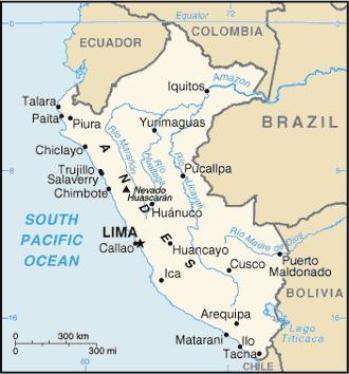
| We met the riverboat at the Nanay Dock. |
| The Heliconia Lodge (right) was our jungle "hotel". During high water, the river rises more than 20 feet to cover this mud bank. During low water, we climbed the rough, steep stairs over the mudbanks. The hotel had limited potable water, cold showers and electricity only 4-6 hours each day... sounds like the boat, huh? We spent only 4 days at the lodge, but during that time took several forays onto the river and into the jungle. One morning was spent in searching for pink dolphins and fishing for piranha. We spent another day trekking through the jungle, visiting local villages and tasting the local aguadiente (white lightening). We spent an evening in a canoe, watching the sunset on the river and listening to night sounds. One morning, we paddled silently watching the sun rise and listening to the river wake up. |
| Several large tributaries converge at Iquitos and feed the Amazon. This ever-changing river is muddy brown, vast and surprisingly warm to the touch. |
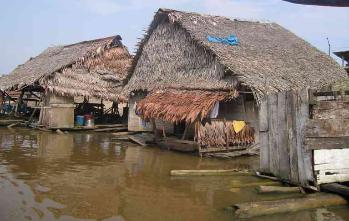
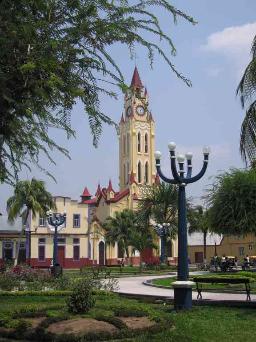
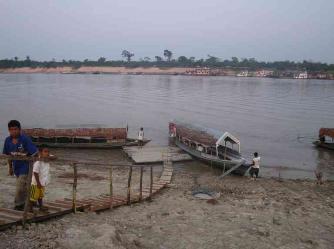
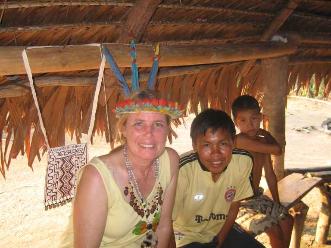
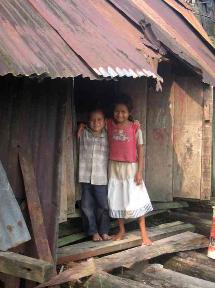
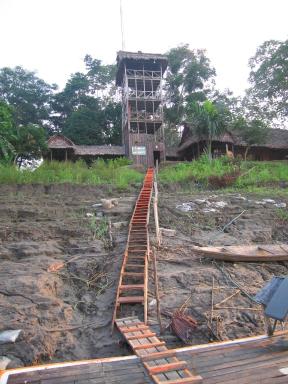
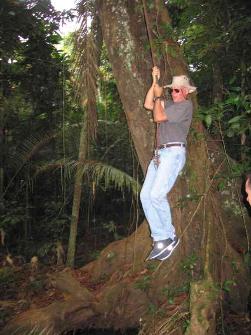
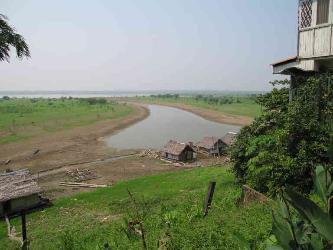
| The locals call them bufeo colorado, but we call them pink dolphins. The color comes not from the diet like the pink flamingo, but rather we're told from capillaries close to the surface of the skin, iron content in the water, water temperature and age of the animal. Local legend has it that the pink dolphin can turn into a handsome man and seduce local young women thus accounting for a number of unexplained pregnancies.Too quick for our digital camera, we borrowed the photo above from the internet. |
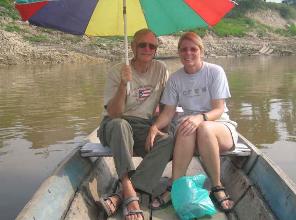
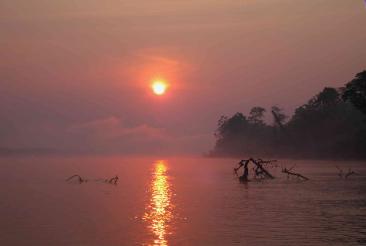
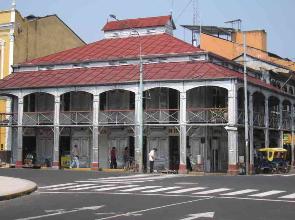
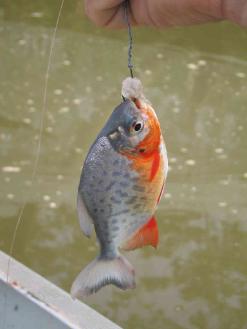
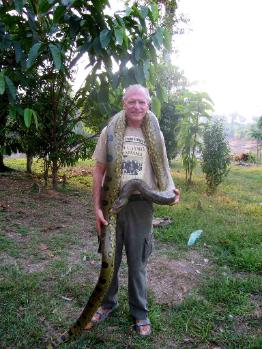
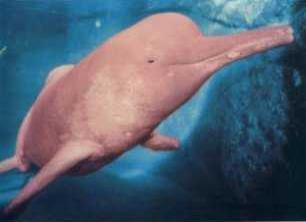
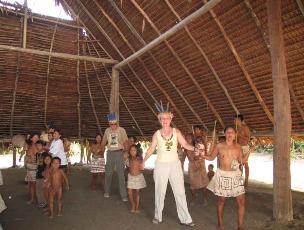
| We've all seen those movies where a cow falls into the Amazon and five minutes later only a skelton remains, the flesh picked clean by piranhas. Huh! Our guide assured us that piranha only go after blood and red meat. We were fishing for piranha on the Amazon one hot, sultry morning when David landed one of the big suckers (it weighed in at close to 5 ounces and was nearly 6 inches long). David disproved the guide's assurances when the "catch of the day" took a bite out of his finger. The guide commented that this was very irregular behavior since David wasn't bleeding at the time. We returned to the lodge in time for lunch and were served this badly behaved piranha as our appetizer at which time David returned the favor...quite tasty! |
| A man sees a long, sturdy vine hanging from a tree in the middle of the jungle...need I say more? |
| The Amazon at sunrise was beautiful and unworldly, the steam rising to meet the sun, portending the heat of the day ahead. This view alone was worth the trip. |
| Back in Iquitos City, we spent a few more days exploring the city itself as well as the local villages along the river. The city itself was LOUD...more mototaxis and motorcycles per capita than we'd ever seen or heard. The building above is the famous Iron House, built by a Rubber Baron during the rubber boom days of the late 1800's. It was designed by Gustave Eiffel, constructed in Paris and shipped in pieces to Iquitos where it was constructed in 1889. It currently houses some shops and a restaurant. |
| These two little waifs were adorable and turned out to be quite the hams. They loved being photographed and posing and especially loved looking at themselves on the tiny LCD screen of the camera. |
| Marcie and David in a canoe on the Amazon. Bob (Roberto preferred his "American" name) was our expert guide and paddler and also the photographer. |
| After reading Lonely Planet and a local tourists' newspaper, The Iquitos News, we made plans to explore some of the little villages along the river. We found a "collectivo" (water taxi) along the dock that was heading in the direction of Padre Cocha and we climbed aboard with the other 25 people heading there. On arrival, we met a young fellow (Jim) who offered to guide us to the Pilpintuwasi Butterfly Farm and a Bora village. |
| After confirming that she had been recently fed, David tries on an anaconda "boa". Marcie, offered the same opportunity, opted to forego the chance and just take a photo. |
| Decked out in headdresses and shell necklaces, we "cut the rug" with the Boras doing the "anaconda dance" (we would have called it "snap the whip"). We were obviously a bit overdressed! |
| Marcie, flushed with the exhilaration of the dance, takes a rest and poses with our jungle guide, Jim. |
| The floating balsa houses of Belen in Iquitos. |
| Another day was spent exploring Belen, touted as the "Venice of the Amazon". The floating houses of this barrio (neighborhood) are all constructed of balsa and rise and fall with level of the river. We wandered through the maze of streets that led to the river's edge and then found a canoe for hire to paddle us around. It was fascinating as we watched children playing, people bathing and women washing clothes in the river, midst the traffic of canoes, water taxis and various other boats. David's comment as we were returning to Lima: "You know, we could have sailed here from the Brazil side! Maybe next time." |
| The cathedral located on the main plaza was ornate and beautiful as always. |
| Amazon facts: *World's second longest river (4,000 miles) and the chief river of South America *The Amazon River Basin covers about 2,700,000 square miles and includes the world's largest tropical rain forest. It is considered the “lungs of the world” since it produces about 15% of the world’s oxygen. *The Amazon rain forest contains a wider variety of plant and animal life than any other place in the world. |
| During 1541 and 1542, a Spaniard, Francisco de Orellana, led the first exploration of the river by a European. During Orellana's journey, his group was attacked by what appeared to be giant female Indian warriors. The Spaniards called their attackers Amazons, after the female warriors in Greek mythology. The name was later given to the river and the nearby area. |
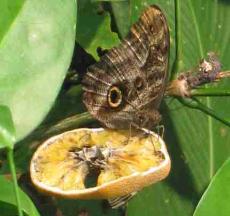
| The butterflies were fine, but actually it was the rest of the animals that intrigued us. It appeared that Gudrud, the Austrian owner, had become the local repository for unwanted and hurt animals. |
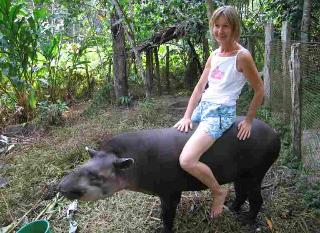
| Gudrud astride a pretty docile tapir. |
| Heliconia, for which the lodge was named, was abundant in the surrounding jungle. |




| One of the remnants of the rubber boom days, these handmade tiles called “azulejos” were imported from Spain and Portugal and used to adorn the facades of the mansions. At first we had to look hard to spot them, but soon they seemed to be everywhere |
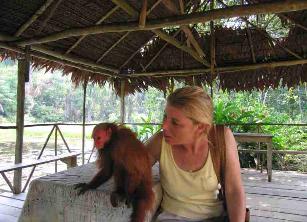
| She also had a jaguar, anteaters and a large assortment of monkeys. It's always a question of who really is the monkey? |
| Jim continued to lead us on well worn paths through the jungle and when we heard the distant beat of drums, we knew we were getting close to the Bora village. It was a tourist presentation, but we were the only people there, so we enjoyed all of their attention. |
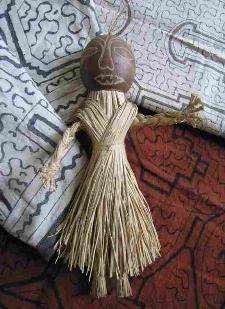
| I always try to collect something unique from the areas we visit. Above, some handmade Shipibo fabric and a Yagua doll. |
| Another adventure comes to an end. We flew back to Lima to spend more time with friends. Click here if you wish to join us back in Peru or follow us to Chile. |